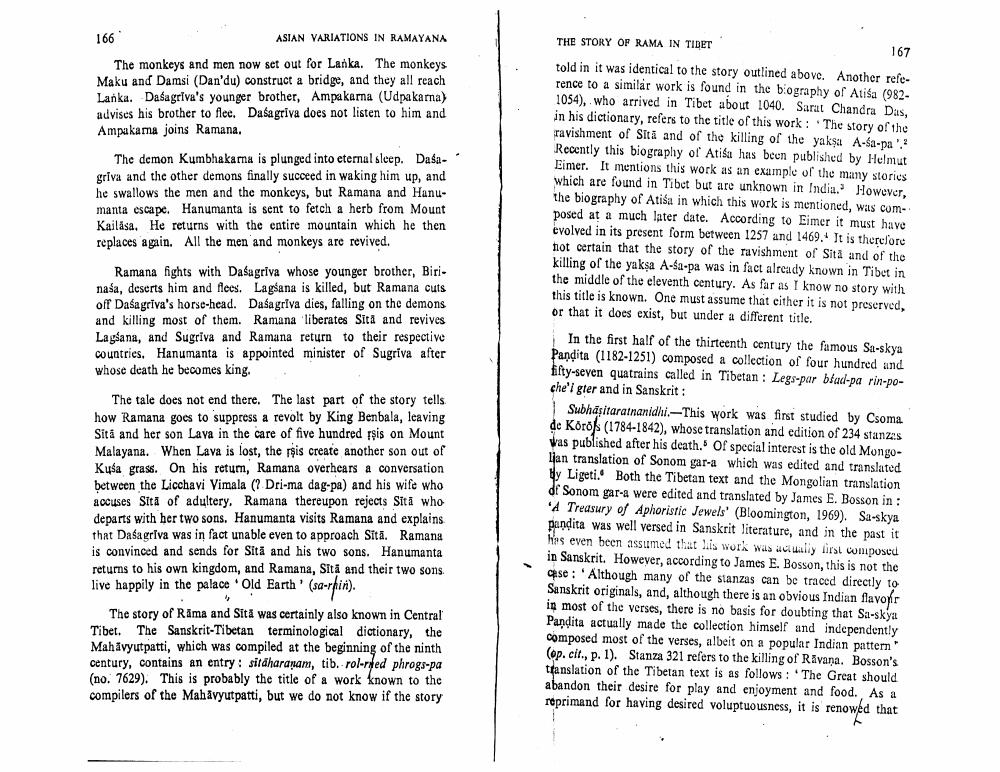________________
166
ASIAN VARIATIONS IN RAMAYANA
The monkeys and men now set out for Lanka. The monkeys. Maku and Damsi (Dan'du) construct a bridge, and they all reach Lanka. Dasagriva's younger brother, Ampakarna (Udpakarna) advises his brother to flee. Dasagriva does not listen to him and Ampakama joins Ramana.
The demon Kumbhakarna is plunged into eternal sleep. Dasagrīva and the other demons finally succeed in waking him up, and he swallows the men and the monkeys, but Ramana and Hanumanta escape. Hanumanta is sent to fetch a herb from Mount Kailasa. He returns with the entire mountain which he then replaces again. All the men and monkeys are revived.
Ramana fights with Daśagriva whose younger brother, Birinasa, deserts him and flees. Lagšana is killed, but Ramana cuts off Dasagriva's horse-head. Daśagrīva dies, falling on the demons and killing most of them. Ramana liberates Sitä and revives Lagsana, and Sugrīva and Ramana return to their respective countries. Hanumanta is appointed minister of Sugriva after whose death he becomes king.
The tale does not end there. The last part of the story tells how Ramana goes to suppress a revolt by King Benbala, leaving Sita and her son Lava in the care of five hundred rsis on Mount Malayana. When Lava is lost, the rsis create another son out of Kusa grass. On his return, Ramana overhears a conversation between the Licchavi Vimala (? Dri-ma dag-pa) and his wife who accuses Sita of adultery. Ramana thereupon rejects Sita who departs with her two sons. Hanumanta visits Ramana and explains that Dasagriva was in fact unable even to approach Sitā. Ramana is convinced and sends for Sitä and his two sons. Hanumanta returns to his own kingdom, and Ramana, Sita and their two sons. live happily in the palace Old Earth' (sa-rfin).
"
The story of Rama and Sita was certainly also known in Central Tibet. The Sanskrit-Tibetan terminological dictionary, the Mahävyutpatti, which was compiled at the beginning of the ninth century, contains an entry: sitäharanam, tib. rol-red phrogs-pa (no. 7629). This is probably the title of a work known to the compilers of the Mahävyutpatti, but we do not know if the story
THE STORY OF RAMA IN TIBET
167
told in it was identical to the story outlined above. Another reference to a similar work is found in the biography of Atisa (9821054), who arrived in Tibet about 1040. Sarat Chandra Das, in his dictionary, refers to the title of this work: The story of the ravishment of Sitä and of the killing of the yakṣa A-sa-pa'. Recently this biography of Atisa has been published by Helmut Eimer. It mentions this work as an example of the many stories which are found in Tibet but are unknown in India. However, the biography of Atisa in which this work is mentioned, was composed at a much later date. According to Eimer it must have evolved in its present form between 1257 and 1469. It is therefore not certain that the story of the ravishment of Sita and of the killing of the yaksa A-sa-pa was in fact already known in Tibet in the middle of the eleventh century. As far as I know no story with this title is known. One must assume that either it is not preserved, or that it does exist, but under a different title.
In the first half of the thirteenth century the famous Sa-skya Pandita (1182-1251) composed a collection of four hundred and fifty-seven quatrains called in Tibetan: Legs-par blad-pa rin-poche'l gter and in Sanskrit:
Subhasitaratnanidhi.-This work was first studied by Csoma de Körös (1784-1842), whose translation and edition of 234 stanzas was published after his death. Of special interest is the old Mongolian translation of Sonom gar-a which was edited and translated by Ligeti. Both the Tibetan text and the Mongolian translation of Sonom gar-a were edited and translated by James E. Bosson in: A Treasury of Aphoristic Jewels' (Bloomington, 1969). Sa-skya pandita was well versed in Sanskrit literature, and in the past it hes even been assumed that his work was actually first composed in Sanskrit. However, according to James E. Bosson, this is not the case: Although many of the stanzas can be traced directly to Sanskrit originals, and, although there is an obvious Indian flavor in most of the verses, there is no basis for doubting that Sa-skya Pandita actually made the collection himself and independently composed most of the verses, albeit on a popular Indian pattern" (op. cit., p. 1). Stanza 321 refers to the killing of Ravana. Bosson's translation of the Tibetan text is as follows: The Great should abandon their desire for play and enjoyment and food., As a reprimand for having desired voluptuousness, it is renowed that




